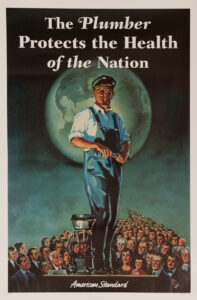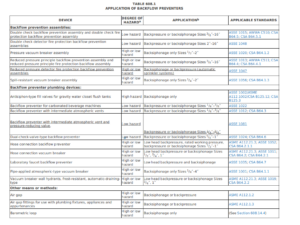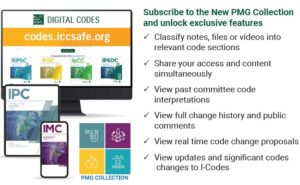
Cross-Connection Control: A Critical Line of Defense Against Potable Water Contamination
We take cross-connection control for granted, but it is critical for safe and clean drinking water.

As I write this article, I am reminded of the old American Standard advertisement, The Plumber Protects the Heath of the Nation poster. It hangs in my living room, and it is a constant reminder that plumbing/cross-connection control professionals help to provide us with potable water where we live, work, play and worship. Plumbers and building safety professionals alike protect our water supply. This starts with understanding how a water system works and how cross-connection control is regulated.
What is cross-connection?
Cross-connection is an actual or potential connection between a municipal water distribution system and any source which would affect the quality of water being delivered.
We take cross-connection control for granted, but it is critical for safe and clean drinking water. Most of us can go to a faucet, water bottle filler or drinking fountain and get a sip of potable water. This is largely due to the fact that cross-connection control is an inherit plumbing design and installation component. Cross-connection control consists of various methods, assemblies and devices, that when installed and maintained properly, safeguard our potable water.
When these controls fail, however, the results can be catastrophic.
Two types of cross-connection
Potable water supply and distribution systems work under positive pressure and there are two types of cross-connection: direct and indirect.
- Direct cross-connection: Direct cross-connection means that the connection to the potable water system is subject to backpressure and back siphonage. Backpressure is when there is an elevation of pressure in the downstream piping greater than the supply pressure, creating a reversal of the normal direction of flow. Back siphonage happens when there is a reduction in the water pressure, causing a sub-atmospheric pressure within the system.
- Indirect cross-connection: Indirect cross-connection is only subject to back siphonage. One form of back siphonage could occur if the municipal water system was turned off due to a leak. Once the water supply no longer has positive pressure the result is less atmospheric pressure in the piping system creating the perfect situation for back siphonage.
Did you know? Modern-day backflow preventers were born from improvements made to the old swinging check valves, or “Clappers”, by installing multiple checks in a series along with a length of straight pipe between the checks.
What Are Backflow and Back siphonage?
Backflow is the unintended reversal flow of water in a piping system, and it can occur when these conditions are met:
- There is a cross-connection, or a passage must exist between the potable water system and another source.
- A hazard must exist in this other source to which the potable water is connected.
- A hydraulic condition or either “back siphonage”, or “backpressure” must occur.
Multiple situations could cause a backflow incident. We need to assume the worst possible situation that could occur and take the necessary steps to protect our water. Keep in mind that even temporary connections need to be evaluated and have proper protection applied.
Back siphonage is a form of backflow due to a reduction in system pressure causing a sub-atmospheric pressure in the piping system.
Backflow and back siphonage are harmful to people and property because they create a risk for contamination. While they cause similar problems, they are remedied differently.
With these terms now defined, we can move on to determining the level of hazard. A containment, or high hazard, is any substance that would impair the quality of water creating a hazard to public health through poisoning or spread of disease. A pollutant, or low hazard, is an impairment to the quality of water that does not create a hazard to public health but would adversely affect the quality of water being delivered.
Regulating Water Systems and Cross-connection Control
Understanding whether you’re dealing with a backflow or back siphonage condition is of the utmost importance in choosing the proper method, assembly, or device to protect your water. Failure to have proper protection will lead to an incident that will contaminate the potable water system.
Air gaps, or the physical separation between the potable water source and the hazard, is the best method of providing cross-connection control. However, this is not always possible. In many cases, the potable water line is directly connected to a non-potable source and must be protected in an approved manner.
Chapter 6, section 608 of the 2021 International Plumbing Code (IPC) is dedicated to the protection of potable water supply for all non International Residential Code (IRC) regulated structures. Chapter 29, section P2902 of the IRC is dedicated to the protection of potable water supply for all IRC-regulated structures.
Table 608.1 in the 2021 IPC is a valuable resource for identifying types of backflow preventers as well as verifying what standards backflow preventers must adhere to and guides the degree of hazard (Low or High Hazzard) and application (backpressure or back siphonage).

You can verify whether an assembly or device meets the required listings in table 608.1 by visiting the ICC-ES PMG site and searching for the listing, asking the design professional of record, or the manufacturer for the required third-party testing per section 303.4 of the 2021 IPC.
Sections 608.2-608.17.10 of the 2021 IPC outline specific requirements based on the type of hazard to the potable water line it is connected to. Included are items such as which plumbing fixtures need to be provided with backflow protection in accordance with ASME A112.18.1/CSA B125.1, as well as a specific requirement for:
- Air gaps
- Connections to carbonated beverage dispenses
- Boiler connections
- Automatic sprinkler and standpipe protection
- Landscape irrigation
- Direct chemical injection
With all these specific life safety provisions dedicated to protecting our potable water, you can understand why I have relied on the IPC for guidance throughout my entire career.
Installing Your Cross-Connection Protection
Once you know how to choose the proper protection based on the level of hazard and application, you can then decide where to install our cross-connection method, device, or assembly.
One location where protection is provided is referred to as containment. This is when an assembly is installed at or near the service connection. Typically, we see this installed just downstream of the water meter. Containment protects the municipal water supply but will not protect the internal water distribution system in a building.
The other location where protection is provided is referred to as isolation. This protects the internal water distribution system, and therefore must be an isolation method, device or assembly installed at the point of connection to the source of the hazard. Simply put, an air gap on a faucet is a method of isolation protection. Failure to install isolation at the point of connection could result in an incident adversely affecting the quality of water to the last free-flowing fixture on the property.
All backflow assemblies and air gaps shall be inspected annually to determine if the assemblies are operable and that air gaps exist. Furthermore, there are specific requirements for testing specific assemblies at the time of installation and annually.
Examples:
When testing a double-check backflow prevention assembly, it needs to be tested using atmospheric pressure (14.7 PSI at sea level); when testing a reduced pressure principal pressure backflow prevention assembly, it is tested with internal water pressure. At first glance, one could mistake these two different assemblies. The Watts 007 and the 009 are examples of two different types of backflow valves that look similar from the top of the valve. If you are not reading the data plate, you might attempt to test the assembly in an unapproved manner.
A barometric loop works on the specific gravity of water and vacuum.
- 2.31ft (of water column = 1psi) x 14.7 (atmospheric pressure at sea level) = 33.9ft.
Knowing the specific gravity and that in a perfect vacuum, water can only be lifted to a point of 33.9 feet, installing a loop at 34 feet is a viable method of cross-connection control. Therefore, you would not test this method in the same way you would test a Pressure Vacuum Breaker. To verify this is properly installed, we measure from the highest free-flowing water outlet to the top of the loop.
A properly sized thermal expansion tank on a closed system will prevent thermal expansion, thus preventing backpressure. There is no testing method for a thermal expansion tank. To properly size, we need to know the BTU of the heat source, total gallons of storage, supply pressure inlet pressure and final temperature of the water delivered, etc. I have found that Watt’s expansion tank calculator, The Bradford white Thermal Expansion and your water heater handout, and the AO Smith expansion tank sizing guide to be good resources for a quick sizing reference. I am confident that other manufacturers of expansion tanks and water heaters have similar resources.
Only personnel who are properly trained to test and rebuild backflow prevention devices or assemblies should do so. However, I will go over a few basic tips to help:
- Always be aware of your surroundings and notice if air gaps are present.
- Check hose bibs or mop sinks for cross-connection control. These are the number 1 locations where a cross-connection occurs. The cross-connection control device on most hose bibs and mops sinks is an atmospheric vacuum breaker (AVB). AVB’s are required to be taken out of service for 12 hours in a 24-hour period. This means that the hose bib or mop sink faucet should not be under constant pressure or always turned on.
- In my experience, state or local water quality control or water utilities are responsible for administering cross-connection control programs. Each state or local jurisdiction might have differing requirements for installers, testers, and inspectors. They do often refer to the adopted plumbing code and add additional requirements. Work closely with your jurisdiction’s cross-connection control programs administer.
- This person can help you understand local requirements for installation, testing, repairing/rebuilding, and documentation.
- Documentation for testing should be part of any cross-connection control program and should follow industry standards. An example of the Texas Department of Commission on Environmental Quality (TCEQ) form can be found here.
- This person can help you understand local requirements for installation, testing, repairing/rebuilding, and documentation.
- Perform a cross-connection control survey when conducting site surveys, installations, or inspections. This will help you identify any potential hazards and address them with the owners. TCEQ has a Customer Service Inspection guide document that can be found here.
- The state of Colorado Department of Public Health and Environment has a great website to assist communities in managing a program.
- When seeking out what qualifications are needed, you will have to check with the state or local jurisdictions for requirements. The ICC PMG Technical Resources team along with the ICC Teaching and Learning Center can provide targeted training upon request.
- An additional resource for designers, contractors, plans examiners and inspectors, is the ICC PMG Membership councils (PMG MC) CodeNotes ™ on Backflow Preventer. The resource can be found here in English and here in Spanish.
- Always check with your local jurisdiction to verify requirements for designing, installing, or testing backflow prevention protection.
- Always follow manufacturing instructions, IPC and state or local requirements for testing. Never use any parts that are not specifically listed for the assembly or device you are repairing or rebuilding. Doing so would not be allowed per the listing of the assembly or device.
Whether you are a design professional, plumbing contractor, inspector, building owner or water user, we all share in keeping our water safe. If we come across a hazard, we need to educate others on the adverse conditions created and help with a solution. When in doubt always contact a local licensed professional to determine the level of hazard, application and what method, device or assembly is needed.
Resources and Training for Plumbing Professionals
Understanding IPC and IRC requirements for the protection of potable water is paramount in a successful cross-connection control program. Furthermore, there are industry terms, mathematical equations/numbers, and definitions with which one must be familiar.
In my career, I attended various training courses and continuing education to stay current on cross-connection control. During my time as a plumbing contractor, I held a Backflow Prevention Assembly Tester (BPAT) License with the Texas Commission on Environmental Control (TCEQ). To fully grasp the complexities of testing and repairing/rebuilding assemblies, I was required to complete a 40-hour classroom training to obtain the BPAT license as well as 24 hours of continuing education over a three-year period to renew it. The International Code Council offers this 40-hour BPAT class, and I highly recommend that all plumbing designers, contractors, and inspectors consider it.
Other resources I have found to be invaluable are:

I would also recommend building your network of plumbing and design professionals. You can do this by joining associations like the International Code Council, American Society of Plumbing Engineers, and the American Backflow Prevention Association, or volunteering to sit on their committees, boards, or councils. The ICC PMG Membership Council is a great way to connect with PMG code, design, standards, contractors, and educator professionals.
As I mentioned at the beginning of this article, everyone has a role to play. We as professionals can help educate the public by hosting community outreach events, performing annual inspections for cross-connection control, recognizing National Backflow Prevention Day (August 16), and hosting plumbing-focused public events during the International Code Council’s annual Building Safety Month campaign. It takes a village to keep our water clean, and we can lead the way.







